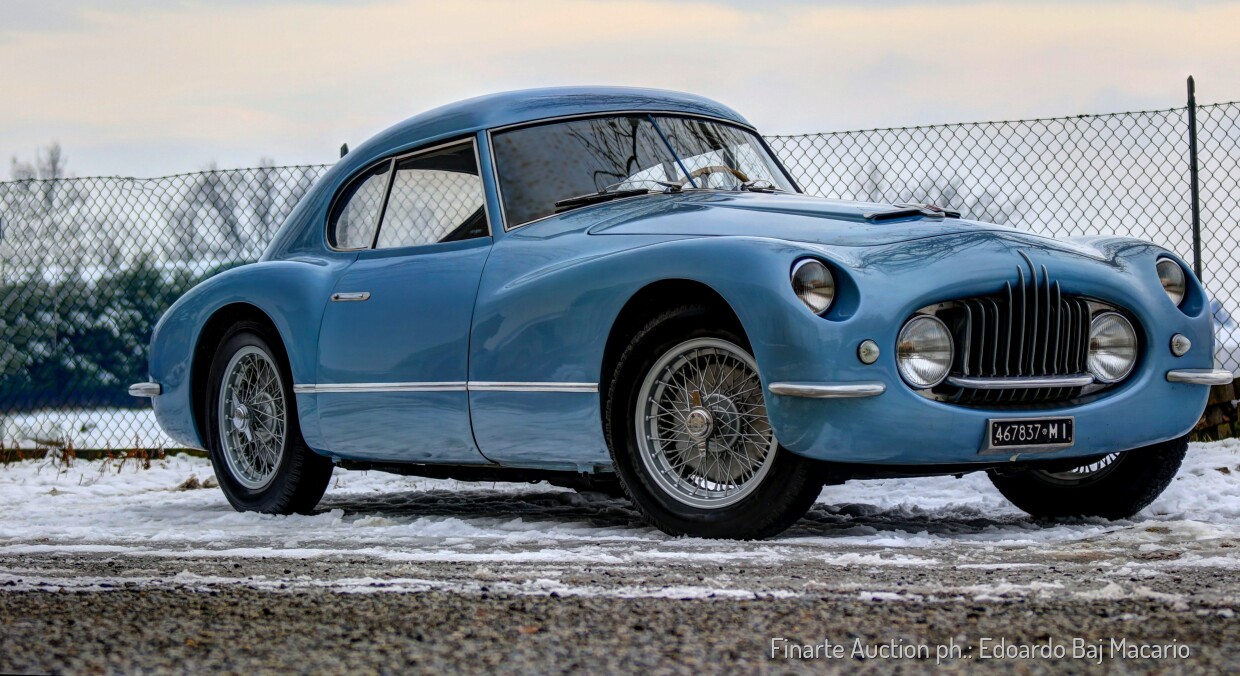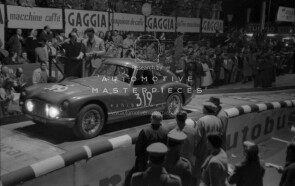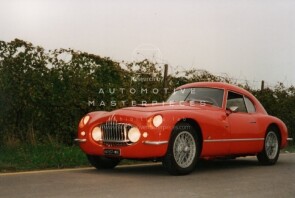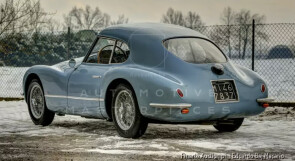
1953 Fiat 8V
ON/OFF
Why am I an Automotive Masterpiece?
G. Team cars
Scuderia Mirabella (I)
L. Limited edition cars
no. 34 manufactured, 8th built
In the postwar period, Fiat was working on an eight-cylinder engine internally known as Tipo 106. The engine was originally designed by Dante Giacosa for a luxury sedan, but that project was stopped. Rudolf Hruska, at the time working at the S.I.A.T.A., was given the task to design a car around the V8 engine. The development took place in absolute secrecy. As not to stress the experimental department of Fiat, production of the chassis was also taken up by S.I.A.T.A. Styled by chief designer Fabio Luigi Rapi, the Fiat 8V or “Otto Vù” was presented to the Italian press in February 1952 and first exhibited the following March at the Geneva Motor Show. The car shapes saw several changes in time: the prototype used an art deco grill extending into the hood which initially characterized the examples of the first series. A second series was made featuring four headlights with some of the later cars having a full-width windscreen. A high-performance coupé, destined to compete in the GT class: the 2-liter 8V model was a departure from the usual Fiat production. It was really welcomed by Italian private drivers, it inspired the tuners and it was, in a word, the car to beat in the 2-liter class, also thanks to the special versions built by Zagato or Siata. The Fiat V8 had a 70° V configuration of 1996 cc of displacement, at 5600 rpm the engine produced 105 hp in standard form with double two-barrel Weber 36 DCS carburetors, giving a top speed of 190 km/h. Some engines were fitted with two huge four-throat Weber 36 IF4/C carburetors offering 120 hp, but the intake manifold was very rare. The Fiat 8V is the only eight-cylinder built by Fiat. The engine was connected to a four speed gearbox. The car had independent suspension all round reworking the Fiat 1100 ones and drum brakes on four wheels. As the body was welded to the chassis it was a semi-unitary construction. Only 114 of these high-performance coupés had been produced, 64 of them with a “Fiat Carrozzerie Speciali” body, 34 first series and 30 second series. It was made available anyway in different body styles, offered by the factory and by various coachbuilders like Zagato, Pinin Farina, Ghia and Vignale. The production ceased in 1954.
Chassis 106.000008 is the second 8V ever built, after the 6 pre-production ones, is the 8th of all the Fiat 8V produced, and for a long time it was believed to be the oldest chassis among the survivors with Fiat bodywork; for this reason, the monographic book dedicated to this car was published in June 2022 with the title "The Earliest Surviving Rapi's Fiat 8v". More recently Tony Adriaensen announced that he had identified, as the oldest chassis number, the surviving 106*000003* still with Fiat bodywork. 26 of 34 first-series cars retained the original shapes designed by Luigi Fabio Rapi and were not re-bodied or modified. Of these 26, there is specific news of only 7 cars surviving to date, 3 were destroyed, and one was dismantled. There is no news about the remaining 15. The car came out of the factory on March 5, 1953, and it was meant for Emanuele Filiberto Nasi, son of lord Carlo Nasi and Tina Agnelli, grandson of Giovanni Agnelli, the late founder of Fiat and Gianni Agnelli’s cousin. The Nasi family was significant Fiat shareholders. Emanuele Filiberto Nasi ordered the car with out-of-series specifications, like the cloth interiors. On the original door panels is the name of the owner written inside. However, due to deterioration, those original panels had to be replaced while restoring the car. Emanuele Filiberto Nasi was the president of the Automobile Club in Torino and a proper gentleman driver ranking 8th overall at the 1948 Mille Miglia with Emilio Christillin on a Fiat 1100 and 2nd overall at the 1950 Rallye del Sestriere on Fiat 1500. He raced 106.000008 at the uphill race of the Colli Torinesi, Sassi-Superga with 128 entry number (TO143309 plate), ranking 7th in class Turismo Internazionale - 2000cc. The car was sold in August 1956 to Benedetto Testa (plate BG38945) and Antonio Siddi, sprinter and bronze medal at the Olympic Games in London 1948, drove it during the 1957 Mille Miglia. Siddi with entry number 319 faced the race alone. He did not finish the race but bought the car in July 1957. The history of Siddi as a racing driver, at that time, is curiously linked to the 8V cars: the organisers of the Mille Miglia agreed with the Romanazzi body shop, owner and tuner of the Fiat 8V series II, chassis no. 106.000102, to entrust it to Siddi under the aegis of the Scuderia Tevere racing team, but he preferred the 106.000008 car, even if it was an older car. Siddi had already participated in the Mille Miglia in 1954 with a Fiat 1100-103, ranking 92nd overall and his life as a racing driver saw him at the primary races in Italy like the 1963 Rally Internazionale della Sardegna with a Triumph TR4 and the 1964 Targa Florio at the wheel of an MG B. In 1960 the car received its “famous origin” new engine and was owned by Giovanni Minozzi, racing driver; Giovanni Minozzi was grandson of Grand Prix driver Antonio Ascari, cousin of Formula 1 champion Alberto Ascari. More recently, in its second life, the car's palmarés included the 1982 Mille Miglia and, later, the 1993/1994/1995/1998 Mille Miglia, with a 16th place overall in 1994 (Saporetti/Montanari). The car also saw most of the 90s editions of the Coppa d’Oro delle Dolomiti, and it won the prize in the Gran Turismo category at the 2015 Vernasca Silver Flag, and the ASI award for the best restoration, at the 2017 Vernasca Silver Flag. The original engine mounted on chassis 106.000008 was substituted early in its life with a not matching but precious unit, since it comes from the famous one-off Siata 208 Coupé Bertone CS068. Fiat 8V chassis 106.000008 has been owned by the famous collector Mario Righini in the early seventies and then held for over forty years in the same family’s collection. The car saw some documented changes. It is believed that it was born with the typical art-deco grille of all the first 8V, with a trim extending on the hood, while appears some years later in the picture at the 1957 Mille Miglia with a simpler grille. The car arrived in the 1980s with a new front nose, with a different opening without grille and streamlined, Plexiglas covered headlights, different taillights, no bumpers and painted in red. In the late 1980s, it was restored to perfect condition, again with the art-deco grille and all the accurate details, while deciding to maintain the red colour. Later, it was decided to achieve the pristine condition, painting the car in the original “grigio bleu metallizzato” (a kind of light blue, while the other two available colours were the “Verde mare metallizzato” and the “grigio rosato”).







